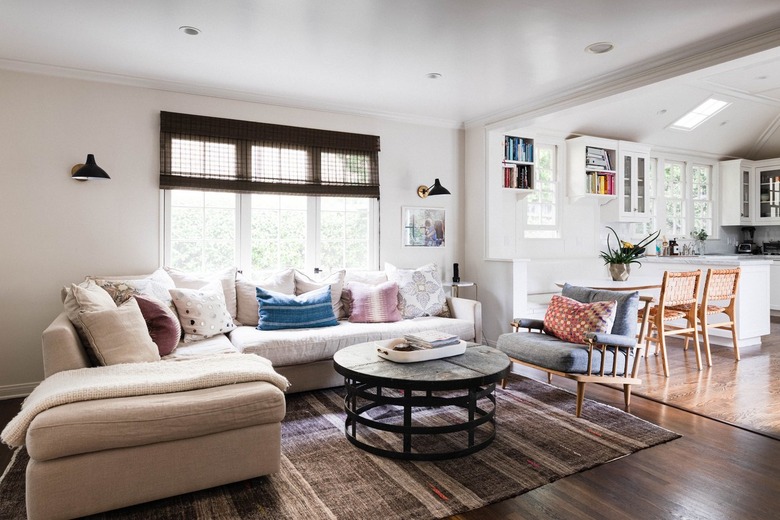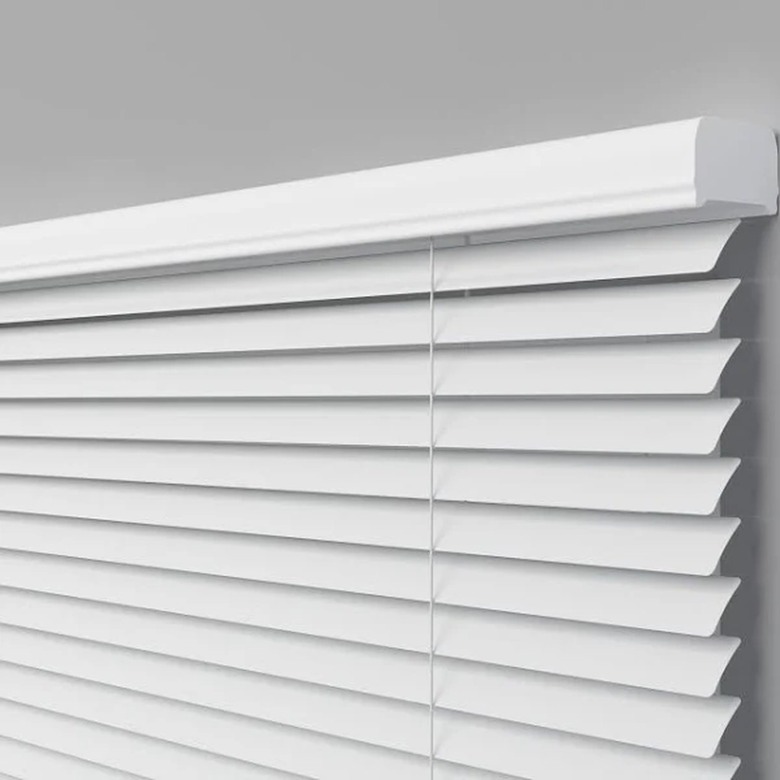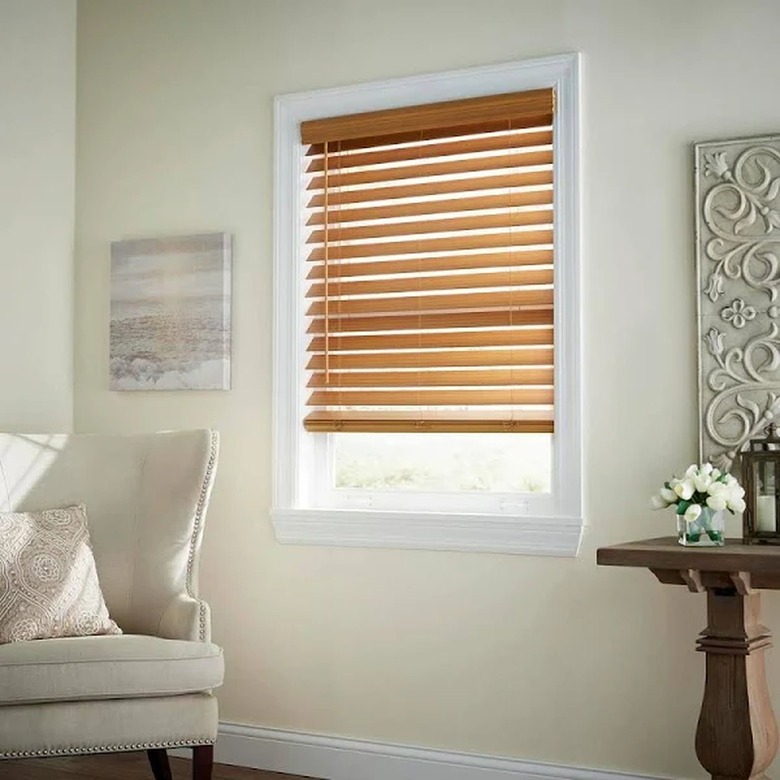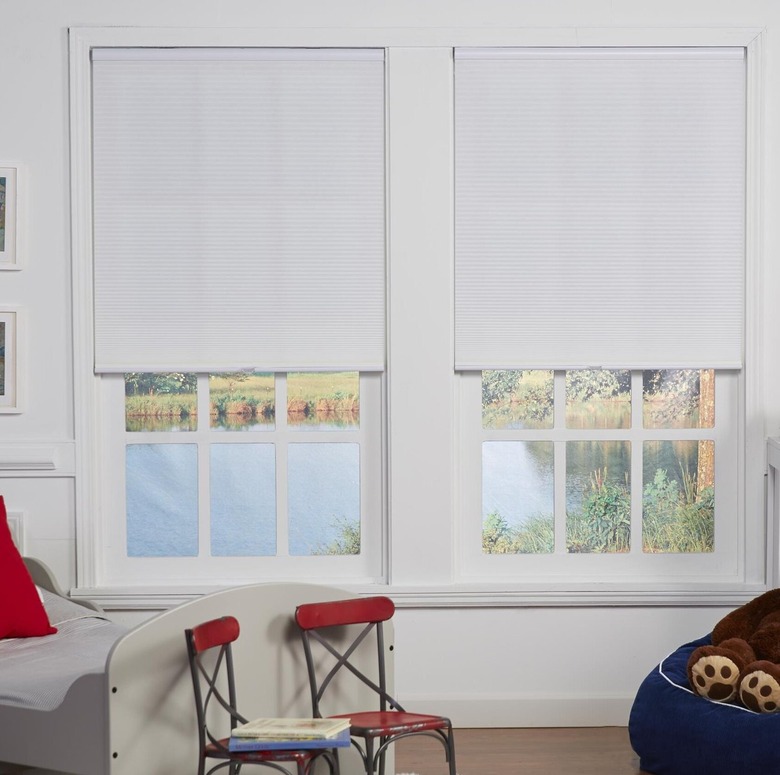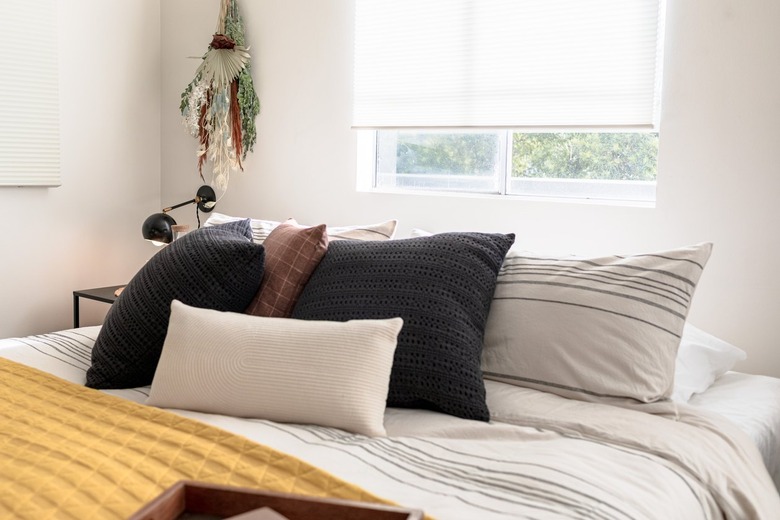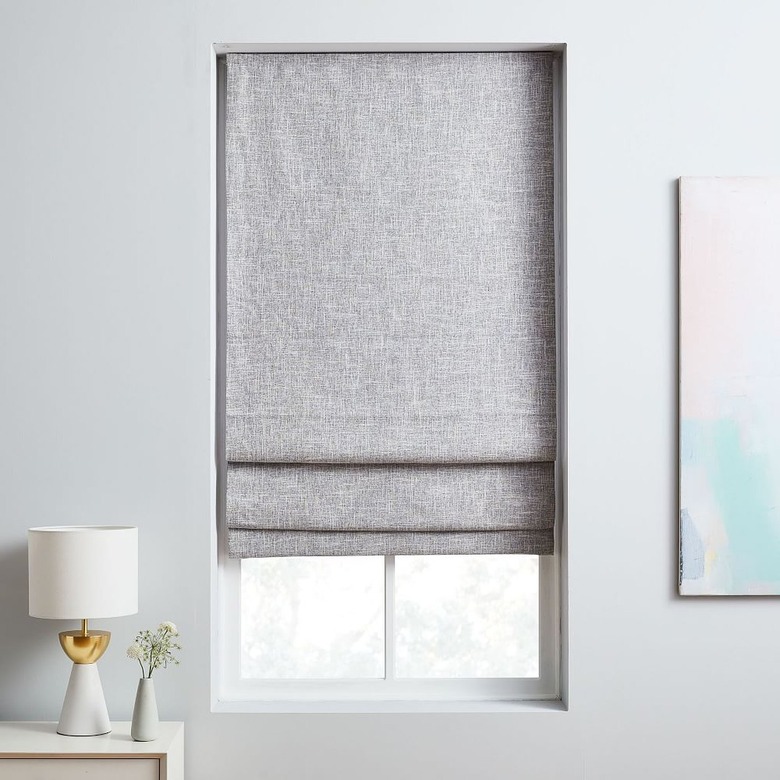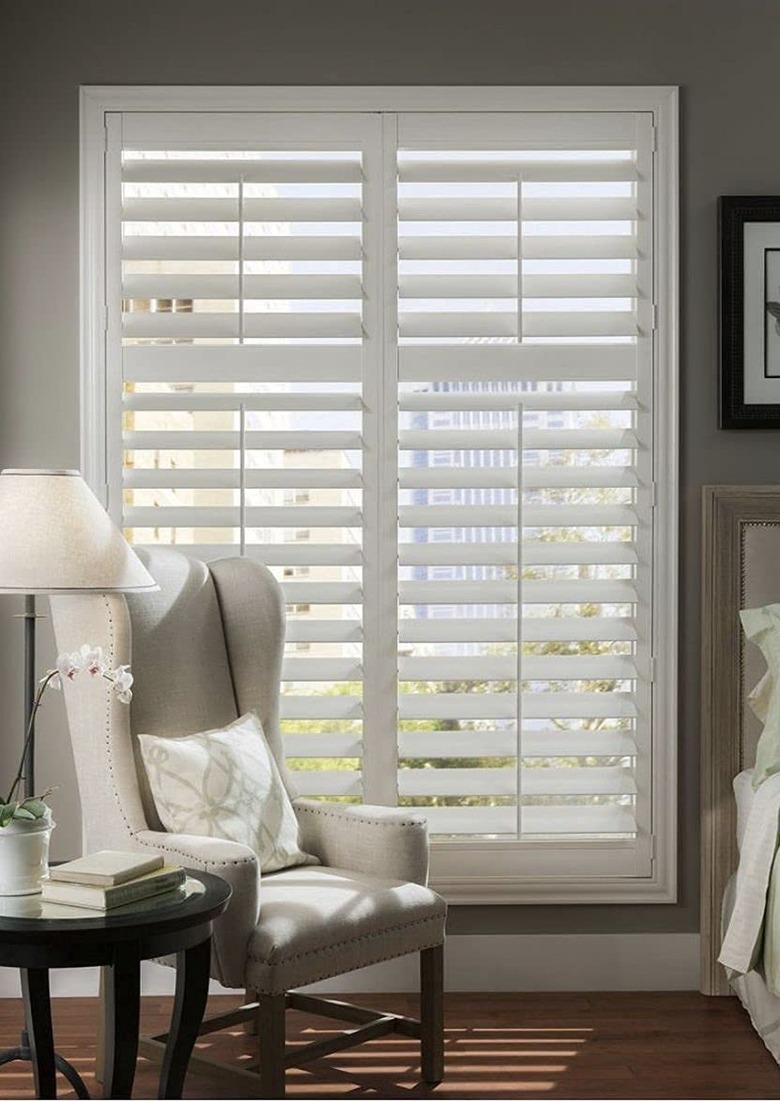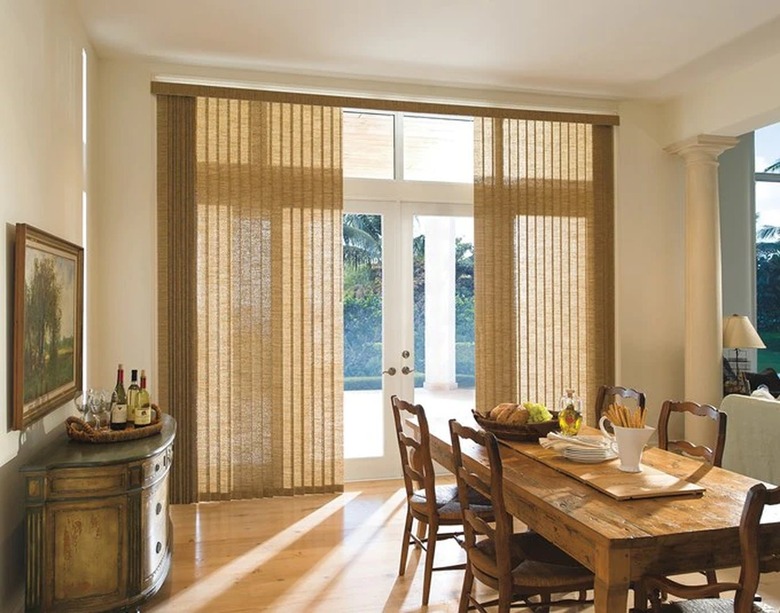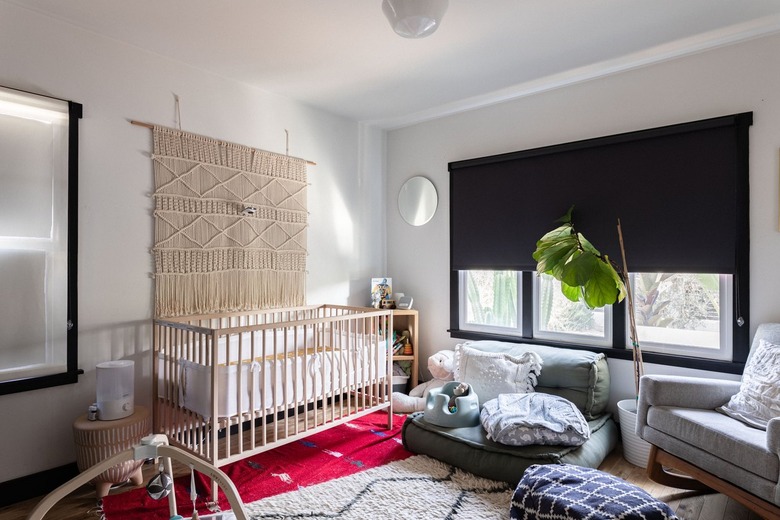The 10 Types Of Window Shades & Blinds To Add The Perfect Finishing Touch
There's a blinding variety of window treatments available today — from purely decorative to sun blocking to a combination of the two. The plethora of options at your disposal guarantees that you can find shades or blinds that will fit your style, your budget, as well as your privacy needs.
Ready to cover up your bare windows? Here are the 10 types of blinds and shades to choose from.
1. Mini Blinds
1. Mini Blinds
Typically made from vinyl or metal, mini blinds make an excellent choice when you want window treatments on the cheap. These blinds consist of curved slats held together by cord. These slats, available in 1/2-inch, 1-inch, or 2-inch widths, are adjustable so you can control how much or how little light comes in through the windows. If desired, you can also raise the blinds completely and pull the slats up and out of view.
Mini blinds made of aluminum tend to last longer than those made of vinyl, but they also tend to be louder and are more likely to bang against the window on a windy day. Aluminum blinds themselves aren't all created equal. The heavier the aluminum gauge, the sturdier the blinds.
Mini blinds come in a wide variety of colors and are quite versatile. Be aware, however, that these are the blinds about which people warn you if you have young children. The cord that pulls the blinds up and down can be quite long, and children and pets have been known to become unsafely tangled in them. Note too that cats and dogs who insist on partaking of the window view are not usually kind to mini blinds left in their way.
2. Wood and Faux-Wood Blinds
2. Wood and Faux-Wood Blinds
Wood and faux-wood blinds can take your mini blind game to the next level. Although they are constructed in the same fashion, these blinds are either real wood or made to look like it. Real wood blinds tend to last a long time, and they can warm up your space. Your color choices become somewhat limited if you want the look of wood, but there are still many different stains and finishes from which to choose.
If you're putting wood blinds in a bathroom or other high humidity area, opt for faux wood rather than the real thing. Faux wood resists moisture much better than the real thing and may also prove more resistant to scratching, cracking, and warping. Genuine wood blinds clean up easily with a dust rag, but you can take faux wood outside and hose it down as often as you need.
3. Cellular Shades
3. Cellular Shades
If you're looking to add a little extra insulation at your windows, consider cellular shades. Cellular shades are made of thin fabric and feature a honeycomb design that creates a series of air pockets throughout the blind. These pockets help to regulate and maintain the temperature whether you're trying to keep the room warm or cool.
When pulled down, cellular shades reveal pleats for a crisp, clean look. They easily collapse on themselves when raised, and flatten to prevent them from obstructing the view when they're open wide. Available in many colors and fabrics, cellular shades filter light to darken the room if desired and provide excellent privacy.
You can opt to close cellular shades from the top down like traditional blinds, or you can choose ones that close from the bottom of the window up. Some are motorized, and many are cordless.
4. Pleated Shades
4. Pleated Shades
Looking much like cellular shades without the air pockets, pleated shades are folded in a pattern much like the paper fans you made as a child. The pleats make for a crisp look, and these blinds are available in almost any color or print you can imagine. You can use them to add a clean, subtle look or go bold with your print and spice up the room. For a modern twist, some blinds now offer extra-wide pleats to add a new twist on an old favorite.
Pleated shades are very customizable and offer a super-slim profile that makes them all but disappear when open. These shades are generally not cordless, however, which can bother those who think the cord is unsightly or are concerned about safety. The cord also means there are pinholes throughout the blinds, which makes them a poor choice in a bedroom or home theater where you may desire a complete blackout.
5. Roller Shades and Solar Shades
5. Roller Shades and Solar Shades
Here's the thing: Maybe you don't really want a window treatment at all. Perhaps you love your massive windows and the incredible view, and don't like the thought of losing that view. At the same time, you likely recognize the need to filter the amount of light that streams in so your furniture doesn't fade, and there are times when a little privacy wouldn't hurt. In this case, you need roller shades.
Roller shades (sometimes called roller blinds) are self-contained shades that roll themselves up into their own casing at the top of the window. You can't really see them when they're up, so they won't interfere with your view or your love of natural lighting. When you want more shade or privacy, simply pull them down as far as you would like. You can choose from a wide variety of colors and fabric opaqueness, from sheer and light filtering to room darkening.
Almost identical to roller shades are solar shades. The difference is that solar shades are made from special fabrics that block ultraviolet rays from entering the room. Blocking UV rays prevents the sun from fading your carpets, furniture, and other materials in your home. It also protects you from the harmful rays of the sun that can cause skin cancer.
As beneficial as solar shades can be, they can't do everything. These fabrics block UV rays but aren't able to provide blackout conditions (some roller blinds can). If you want both, you'll have to combine your solar shade with dark blackout curtains.
6. Roman Shades
6. Roman Shades
If you can't decide between shades or fabric curtains for your window treatments, consider Roman shades. Named after their resemblance to the awnings used in the ancient Roman Colosseum, Roman shades are made of fabric that creates a series of soft folds as it is lowered. They come in a wide variety of styles, colors, and patterns like traditional draperies but maintain the look and feel of a window blind.
Because they require less fabric, Roman blinds allow you to have the look and feel of fabric for much less than a traditional window curtain. Roman shades don't perform well in kitchens, bathrooms, and other damp areas where staining could be an issue, though. They also require regular dusting and maintenance to keep them looking their best. You can highly personalize them, however, and they are lightweight.
7. Interior Louvered Shutters
7. Interior Louvered Shutters
Shutters are timeless and versatile, easily completing a farmhouse look or adding the finishing touch to a beach cottage feel. Available in wood or composite material, shutters come with louvers of varying width to create different looks and levels of privacy. Some shutters have moveable louvers that you can close for added privacy, but some are stationary and may provide lots of light but little protection from the neighbor's eyes.
You can open some shutters, but depending on how they're mounted, they will swing into the room when they're open, which can feel a little cramped in a small space. Shutters tend to cost more than other window coverings, and though they are attractive, they are always visible. You can't tuck them away like you can a roller blind, for example, so choose shutters you won't get tired of admiring.
8. Vertical Blinds
8. Vertical Blinds
If you have extremely tall, wide windows or need to cover a sliding glass patio door, vertical blinds can do the trick. Vertical blinds are basically mini blinds turned sideways. As their name suggests, the slats of vertical blinds run vertically rather than horizontally. You can still twist them closed for full privacy or tilt them to let in the sunshine. To open them fully, however, you slide them to the left or right.
This sliding action gets the blinds completely out of the window or door so you can walk out onto your patio or simply enjoy an uninterrupted view. If you wish, you can customize your vertical blinds and have them made of fabric or have the slats built in a curved shape that looks softer. Fabric blinds tend to pick up dirt from the floor more quickly, however, and may prove difficult to keep clean. Vertical blinds made of firmer materials tend to clack together when disturbed, which some people find annoying.
9. Outdoor Shades
9. Outdoor Shades
Typically available in white, gray, or black weather-resistant fabric, outdoor shades are a special type of window treatment. Outdoor shades are used outside to protect patios, porches, sunrooms, and other open spaces. Outdoor shades block sunlight, but they also use special hardware to keep them stationary so they don't billow around in a breeze.
Like indoor window treatments, outdoor shades come in a wide variety of opaqueness levels so you can let the light shine in even when the shades are down or choose a thicker shade for more privacy. Outdoor shades come in several different styles as well, although a roller style is one of the most popular. Even if your blind stays put in a stiff breeze, any cords that hang from them won't stay still.
10. Blackout Shades
10. Blackout Shades
Blackout shades are unique in that they aren't necessarily their own type of shade. A blackout shade is really any window treatment that can darken a room completely by preventing any light from getting through. Some people want blackout curtains because they work the night shift and need light control to sleep during the day. Others may want to prevent glare in a home theater. Blackout curtains are often quite heavy, which can block some noise as well as light.
Whatever the reason, you need to know that you'll never achieve full blackout status with mini blinds, shutters, or pleated blinds. The design of these blinds innately contains small holes and areas where some light will always creep in. You can achieve blackout status with most other window treatments, however. To do so, it helps to opt for heavier fabrics in darker colors. Some window treatments are also lined with an opaque fabric that will keep out the light.
In some cases, you may need to combine window treatments in order to block out the light. A combination of mini blinds paired with a heavy drape, for instance, can work quite well. You can buy special blackout drapes and blinds, but they tend to be quite plain and less than fashionable. You may be better off combining multiple window treatments.
References
- A Little Design Help: Pros and Cons of Pleated Shades
- Budget Blinds: Pros and Cons: Faux Wood vs. Wood Blinds
- Scot Blinds: Pros and Cons of Roman Shades
- Zebra Blinds: Pros and Cons of Solar Shades
- The Shade Store Blog: A Guide to Different Types of Window Shades
- US Blinds: Shutters: The Pros and Cons
- Avalon Flooring: All About Vertical Blinds
- Home Depot: Types of Window Treatments
